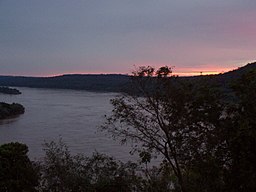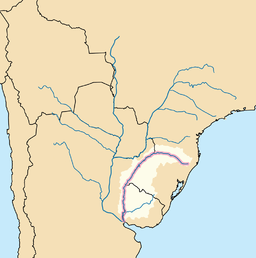Río Uruguay
| Uruguay River | |
| Río Uruguay, Rio Uruguai | |
|
Sunset in the Uruguay River, from Misiones, Argentina
|
|
| Countries | Argentina, Brazil, Uruguay |
|---|---|
| Source | |
| - elevation | 1,800 m (5,906 ft) |
| Mouth | Río de la Plata |
| - elevation | 0 m (0 ft) |
| - coordinates | 34°12′S 58°18′W / 34.200°S 58.300°WCoordinates: 34°12′S 58°18′W / 34.200°S 58.300°W |
| Length | 1,838 km (1,140 mi) |
| Basin | 365,000 km2 (140,000 sq mi) |
| Discharge | |
| - average | 5,500 m3/s (194,000 cu ft/s) |
|
Map of Uruguay River's basin
|
|
The Uruguay River (Spanish: Río Uruguay, Spanish pronunciation: [uɾuˈɣwai]; Portuguese: Rio Uruguai, Portuguese pronunciation: [uɾuˈɡwaj]) is a river in South America. It flows from north to south and forms parts of the boundaries of Brazil, Argentina, and Uruguay, separating some of the Argentine provinces of La Mesopotamia from the other two countries. It passes between the states of Santa Catarina and Rio Grande do Sul in Brazil; forms the eastern border of the provinces of Misiones, Corrientes, and Entre Ríos in Argentina; and makes up the western borders of the departments of Artigas, Salto, Paysandú, Río Negro, Soriano, and Colonia in Uruguay.
The river measures about 1,838 kilometres (1,142 mi) in length and starts in the Serra do Mar in Brazil, where the Canoas River and the Pelotas River are joined, at about 200 metres (660 ft) above mean sea level. In this stage the river goes through uneven, broken terrain, forming rapids and falls. Its course through Rio Grande do Sul is not navigable.
...
Wikipedia


